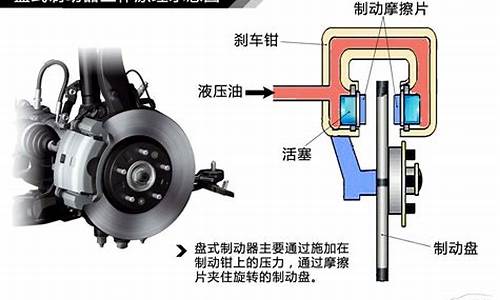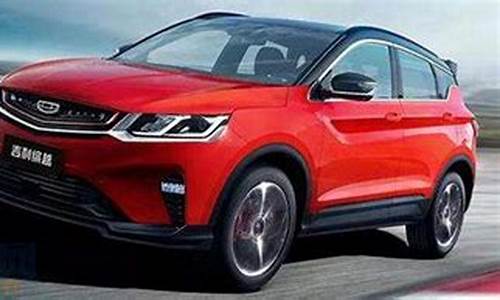您现在的位置是: 首页 > 汽车资讯 汽车资讯
汽车制动原理翻译成英文怎么写,汽车制动原理翻译成英文
tamoadmin 2024-05-17 人已围观
简介ABS即刹车防抱死系统。其因为全拼为Anti-locked Braking System,它是一种具有防滑、防锁死等优点的汽车安全控制系统。与ABS系统相对的为MABS,其全称为Mechanical Anti-locked Braking System,中文解释为“机械式防抱死制动系统”。 MABS系统的工作原来是用机械的方式模仿ABS,但效果相去甚远。ABS系统的工作原理基本就是通过电脑控制刹车

ABS即刹车防抱死系统。其因为全拼为Anti-locked Braking System,它是一种具有防滑、防锁死等优点的汽车安全控制系统。与ABS系统相对的为MABS,其全称为Mechanical Anti-locked Braking System,中文解释为“机械式防抱死制动系统”。 MABS系统的工作原来是用机械的方式模仿ABS,但效果相去甚远。
ABS系统的工作原理基本就是通过电脑控制刹车泵,当驾驶者踩下急刹车时让车轮始终处于“抱死的零界点”,相当于不停的“刹车、放松、再刹车、再放松”,频率约为每秒60-120次。装备ABS系统可以让车辆在紧急刹车的状态下保证方向不失控,且不出现因为轮胎抱死而产生的侧滑。从而提高车辆的安全性。而MABS系统由于ABS刹车防抱死系统的普及率较高,同样可以做到让刹车系统处于“抱死-松开-抱死-松开”的状态下工作,不过其工作频率每分钟只有数百次,效果有一定差距。
EBD电子制动力分配系统。其英文全称为Electric Brakeforce Distribution。它的工作原来是在汽车制动的瞬间,电脑计算出四个轮胎接触路面时的不同摩擦力数值,并调整制动力的分配。
EBD实际上是ABS的辅助功能,它可以提高ABS的工作效率,从而进一步确保车辆制动时的平稳与安全。
ESP是Electronic Stability Program的缩写,车身电子稳定控制系统,安全配置当中举足轻重的角色,大大提高了车身的可控性,这也是以大众为首的产品中常见的配置,与此类似的还有VSC——Vehicle Stability Control、DSC——Dynamic Stability Control等等电子系统,原理、作用都类似,当然,还是ESP最有名。
制动系统 Braking Systems
由于字数太多所以就不全部粘贴了。
brake is a device for slowing or stopping the motion of a machine or vehicle, or alternatively a device to restrain it from starting to move again. The kinetic energy lost by the moving part is usually translated to heat by friction. Alternatively, in regenerative braking, much of the energy is recovered and stored in a flywheel, capacitor or turned into alternating current by an alternator, then rectified and stored in a battery for later use.
Note that kinetic energy increases with the square of the velocity (E = 1/2·m·v2 relationship). This means that if the speed of a vehicle doubles, it has four times as much energy. The brakes must therefore dissipate four times as much energy to stop it and consequently the braking distance is four times as long.
Brakes of some description are fitted to most wheeled vehicles, including automobiles of all kinds, trucks, trains, motorcycles, and bicycles. Baggage carts and shopping carts may have them for use on a moving ramp.
Some aeroplanes are fitted with wheel brakes on the undercarriage. Some aircraft also feature air brakes designed to slow them down in flight. Notable examples include gliders and some WWII-era fighter aircraft. These allow the aircraft to maintain a safe speed in a steep descent. The Saab B 17 dive bomber used the deployed undercarriage as an air brake.
Deceleration and avoiding acceleration when going downhill can also be achieved by using a low gear; see engine braking.
Friction brakes on cars store the heat in the rotating part (drum brake or disc brake) during the brake application and release it to the air gradually.
Effects on noise pollution
The action of braking for motor vehicles produces recognizable sound level emissions, varying with the specific tire types and with the roadway surface type produces considerable effect upon sound levels or noise pollution emanating from moving vehicles.[1] There is a considerable range in acoustical intensities produced depending upon the specific tire tread design and the rapidity of deceleration required to slow the vehicle.
[edit] See also
Archaic past tense of break (see brake)
Air brake (aircraft)
Air brake (rail)
Air brake (road vehicle)
Bicycle brake systems
Brake-by-wire (or electromechanical braking)
Brake lining
Brake pad
Brake shoe
Bundy tube
Disc brake
Drum brake
Electromagnetic brake
Electronic Parking Brake
Engine braking
Hand brake
Hydraulic brake
Jake brake also known as J braking
Overrun brake
Parking brake
Railway brake
Regenerative braking
Threshold braking
Trail braking
Vehicle brake
---------
How brakes work
Of all the systems that make up your car, the brake system might just be the most important. In the olden days it was also one of the simplest. Over the years as improvements have been made, the system that has evolved isn't so simple anymore... (It's also about a zillion times more reliable and safer.)
Your brakes work as hard or harder than any other part of the car, however much energy it takes to get your car up a hill, it takes at least as much energy to stop it at the bottom. Think about that for a second. Here, I'll say it again, it takes at least as much energy to get your car safely down a hill and stop it at the bottom, as it took to get your car up the hill in the first place. Your brakes do this by converting the kinetic energy to heat energy. All of this heat is generated between the friction surfaces of your brake pads and your rotors. (I am going to disregard the rear brakes for now, since the front brakes do the lion's share of the work.)
Rather than try to give you a step-by-step procedure for repairing your brakes, I'm going to try to show you how to diagnose a few of the many simple brake problems. Unfortunately, before I can do that, I have to talk about how the brake system works. If you already know how it works, then you probably already know what your problem is, but you might find something useful here anyway or at least I hope so.
Brakes operate on a simple hydraulic principle. (See diagram below) If a force is exerted on the piston putting pressure on the fluid confined in the left hand container, the fluid is forced out through the narrow tube at the bottom and into the right hand container, exerting a force on the second piston, forcing it to move upward.
Now this is how the force from your foot gets to the four corners of the car. If we add a lever to magnify the force applied to the first (master) cylinder, and maybe even a power booster unit to increase that force even more, all we have to do next is figure a way to use that force to slow down the wheels. Since the wheels are attached to the car, slowing them down will slow the car.
If we change the shape of the right hand container, (see below) to make something for the piston to push against, we can make it pinch something. Let's bolt a disc(Brake rotor) to the wheel, so that it rotates whenever the wheel does. We'll mount it in such a way that the edge of it is between the caliper piston and the caliper that we have bolted to the axle of the car.so that when the piston moves out, the disc is pinched between it and the other side of the caliper. Actually we're not quite done. As we have the system now, the disc and the caliper would wear out rather quickly (not to mention making horrible grinding/scraping noises). We need to put something between them to protect the surfaces. Let's call this part "Brake Pads" But wait, as we have drawn it, the piston only pushes on one side of the disc. We have to allow the caliper to slide back and forth if we want it to actually pinch the disc efficiently. Let's make an anchor post and allow the caliper to slide along it. Let's make a nice, strong mount to hold the brake pads, and secure it to the axle. Now all we have to do is mount the caliper assembly to some sturdy part of the car and we're in business.
Brake pads have two main parts, the steel backing, and the actual friction material. The backing is only there to support the friction material, which does the actual work of stopping the car. The friction material does it's job by converting the energy of motion to heat energy. This is done by the magic of friction. The friction between the pad and the disc slows down the disc, and creates heat. This heat is transferred to the pad and the disc and then (at some fixed rate) dissipated to the surrounding air. How fast that heat is radiated is determined by a simple formula, depends on mainly two factors, the temperature of the air around the parts, and the flow of air past them. 99% of the time, this cooling is more than enough to keep the brakes cool enough to work just fine.
OK, now we have our simple brake system. Let's see what can go wrong...
Air in the system This is usually caused by air getting into the brake fluid area, usually from the master cylinder. As the brake pads wear, the caliper pistons ride farther out of the caliper, allowing more fluid to remain in the calipers. Over time this can add up to almost as much fluid as there is in the master cylinder reservoir. If neglected, this will allow the master cylinder to pump some air into the brake lines. Air is very compressable, whereas brake fluid is not, as long as there is a solid stream of brake fluid between the master cylinder piston and the caliper piston, the brake pedal will be nice and firm. If there is air in the system, the pedal will feel spongy and will go down almost all the way to the floor, maybe all the way, depending on how much air is in the system. The standard way of dealing with air in the brake system is to perform an operation called "bleeding the brakes".
Hard brake pedal: Can be caused by bad power booster, (or loss of vacuum to the booster) seized caliper pistons, seized caliper slides, pinched brake lines, and (rarely) problems with the pedal linkage under the dash. The probable best fix is rebuilt calipers,and new pads.
Brake fade: I have seen too much of this, having spent 5 years at the bottom of a 13 km hill with 15% grade and continuous switchbacks. Two phenomena contribute to brake fade, one is the fact that the coefficient of friction of most substances gets lower at high temperatures, and that most liquids will boil at some temperature, and that gases compress, while liquids do not. When you use the brakes to decelerate 3,000 or 4,000 or 7-8-15,000 lbs of vehicle, they get hot. Very hot. Under normal circumstances this would be no big deal, the heat that builts up in the pads, rotors, and calipers will slowly radiate back to the air flowing over them as the car continues down the road. But you aren't going down the road, you are back on the brakes, doing more decelerating for the next switchback. Instead of cooling off, your brakes are getting hotter. And hotter, and hotter. . .As the pads and rotors get hotter the friction material of the pads starts to separate. The binding agent starts to boil off from the surface of the pad, plating out on the rotor as a dark, paintlike film...coefficient of friction approaches zero, pedal gets hard, but no braking action. Your pupils dilate to 10 mm and your body goes into fight-or-flight mode, adrenalin courses through your system. But the car just goes faster.... You shift down, now you are standing on the brake pedal with both feet, around this time, the temperature of the brake fluid in the calipers usually reaches it's boiling point and the pedal just sinks to the floor. Your pupils reach 12 mm, your sphyncters contract to pinpoints, somehow you manage to stop the car. There is smoke coming from behind your front wheels, maybe fire. You put out the fire and have lunch. After things cool off you sit in the car and try the brake pedal, it feels almost normal. Congratulations, you've just experienced, (and survived) brake fade. (You've also just flash-fried your front brakes, figure on new everything to fix it properly.)
Brake squeal: This is a high pitched squealing noise, often heard when you are going slow and are not applying the brakes. If it goes away as you apply the brakes, it could be coming from the brake wear sensors. (Also called 'squealers' by mechanics.) They are small bits of spring steel that are attached to the brake pads in such a way that when the pads are about 75% worn out, the sensors start to rub on the rotors, making the noise. GM invented them, and they are one of the best ideas anyone has ever had in the automotive industry. The sound is so scary that you usually go to a mechanic before any major damage is done to your rotors, and before your braking power is compromised, saving you money and maybe your life.
Grinding noise: Although this is one of the nastiest sounds you will ever hear, it often is the easiest to repair. The first thing you must do is learn what is making the noise. Figure out which wheel it is, then, after safely raising and supporting the car, take off the wheel & tire. Hopefully you will see a simple disc brake system, with a rotor, a caliper, and brake pads. Identify the various components. Gently rotate the brake rotor back and forth until you can identify the source of the noise. Sometimes it is just a small stone, trapped between the brake rotor and the air deflector. The faces of the rotor should be smooth and clean. If you see large scaly rusted places on the friction surfaces of the rotor you should replace them. Most of the time new ones cost less than you would guess. If your pads are worn out(less than 3/16 of an inch of friction material left) and you catch it in time, all you have to do is install new brake pads. If the surface of the rotor is damaged, you will have to resurface or replace it.
Brake pedal pulsation: There are a lot of things that can cause this, from out-of-adjustment wheel bearings to rotors that are bent, brake drums that are out-of-round, rusty spots on the rotors that have a different surface smoothness. To determine whether the pulsation is coming from the front or the rear wheels, check to see if you can feel the pulsation in the steering wheel when the pedal is pulsating. If you can, the problem is coming from the front wheels.
Brake pull: Mostly this one comes from either a caliper piston seized or caliper slides seized. This one is dangerous! If your car tries to turn when you apply the brakes you could veer into oncoming traffic. What often happens with this one is this: the caliper piston on one side starts to seize, the other one now applies first, car veers away from bad part. Driver learns to compensate by steering opposite to the pull every time he brakes. A panic situation comes along, driver nails the brakes, steers away from the expected pull, but because the piston was only partially seized, it works just fine when the brakes are applied with vigor. There is no pull this time. It is easy to lose control of your car in situations like this, if your car pulls to one side or the other when you brake, fix it(or get it fixed) before you hurt somebody. Replace calipers and pads and service the caliper slides.
Brake grabbing: When you just barely touch the brake pedal and one or more wheels locks up and skids. This one most commonly comes from contaminated friction material on one or more brakes.
Pedal goes to the floor: Gotta be the scariest of them all. If you're lucky, a quick pump on the pedal will get you some braking action. On most newer cars, there will be some braking just before the pedal reaches the floor. Stop driving and check your fluid level. It might just need to be topped up to temporarily get you some braking action to get you home. Regardless, you must find out what caused it and fix it before you drive any further.
Components
Disc brakes have:
brake calipers
brake pads
rotors
caliper mounting hardware
Drum brakes have:
brake backing plates
brake drums
brake shoe self-adjusters
brake shoes
brake springs
wheel cylinders
Both types use:
Brake fluid
Steel brake lines and reinforced rubber brake hoses
Master cylinder
Power brake booster (usually)
proportioning valve
delay valve
metering valve
brake warning light
park brake cables, levers,









